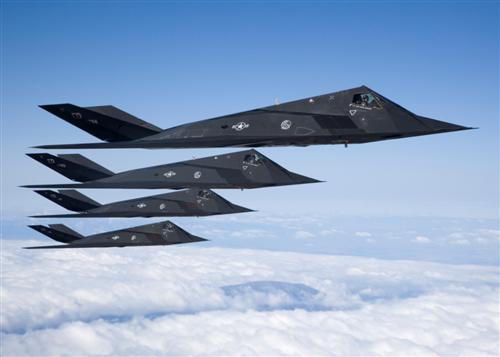

The F-117A Nighthawk is the world's first operational aircraft designed to exploit low-observable stealth technology. The unique design of the single-seat F-117A provides exceptional combat capabilities. About the size of an F-15 Eagle, the twin-engine aircraft is powered by two General Electric F404 turbofan engines and has quadruple redundant fly-by-wire flight controls. Air refuelable, it supports worldwide commitments and adds to the deterrent strength of the U.S. military forces.
The F-117A can employ a variety of weapons and is equipped with sophisticated navigation and attack systems integrated into a state-of-the-art digital avionics suite that increases mission effectiveness and reduces pilot workload. Detailed planning for missions into highly defended target areas is accomplished by an automated mission planning system developed, specifically, to take advantage of the unique capabilities of the F-117A.
The first F-117A was delivered in 1982, and the last delivery was in the summer of 1990. The F-117A production decision was made in 1978 with a contract awarded to Lockheed Advanced Development Projects, the "Skunk Works," in Burbank, Calif. The first flight was in 1981, only 31 months after the full-scale development decision. Lockheed-Martin delivered 59 stealth fighters to the Air Force between August 1982 and July 1990. Five additional test aircraft belong to the company.
The stealth fighter emerged from the classified world while stationed at Tonapah Airfield with an announcement by the Pentagon in November 1988 and was first shown publicly at Nellis in April 1990. The 4450th TG was deactivated in October 1989, and was reactivated as the 37th Tactical Fighter Wing.
The F-117A first saw action in December 1989 during Operation Just Cause in Panama. Two F-117A fighters targeted the field outside the Panamanian Defense Forces barracks at Rio Hato with BLU-109 2,000 lb. bombs to stun and disorient the troops quartered in those barracks in preparation for an assault by US Army Rangers. Technical failures and communications mixups caused the pilots to miss their targets, dropping the bombs farther away from the barracks than intended.
The stealth fighter attacked the most heavily fortified targets during Desert Storm (January-February 1991), and it was the only coalition jet allowed to strike targets inside Baghdad's city limits. The F-117A, which normally packed a payload of two 2,000-pound GBU-27 laser-guided bombs, destroyed and crippled Iraqi electrical power stations, military headquarters, communications sites, air defense operation centers, airfields, ammo bunkers, and chemical, biological and nuclear weapons plants.
Although only 36 stealth fighters were deployed in Desert Storm and accounted for 2.5 percent of the total force of 1,900 fighters and bombers, they flew more than a third of the bombing runs on the first day of the war. In all during Desert Storm, the stealth fighter conducted more than 1,250 sorties, dropped more than 2,000 tons of bombs, and flew more than 6,900 hours. More than 3,000 antiaircraft guns and 60 surface-to-air missile batteries protected the city, but despite this seemingly impenetrable shield, the Nighthawks owned the skies over the city and, for that matter, the country. The stealth fighter, which is coated with a secret, radar-absorbent material, operated over Iraq and Kuwait with impunity, and was unscathed by enemy guns.
F-117 fighters deployed to the Gulf several times during the late 1990's to support U.S. attacks against Iraq designed to deprive Saddam Hussein of his Weapons of Mass Destruction (WMD) programs and to force his compliance with the UN monitoring regime. F-117 fighters deployed to the Gulf during Operation Desert Fox to upgrade the strike force's capability to attack high-value targets. But the 18 hour flight from the F-117s' home base to Kuwait meant that the operation was over before the F-117 aircraft arrived in the Gulf.
In the opening phase of Allied Force, aimed primarily at Yugoslavia's integrated air defense system, NATO air forces conducted more than 400 sorties. During the first two night attacks, allied troops in the air and at sea struck 90 targets throughout Yugoslavia and in Kosovo. F-117 Nighthawks from the 8th Expeditionary Fighter Squadron at Holloman Air Force Base NM participated in air strikes against targets in the Balkans during NATO operations. One F-117 fighter was lost over Yugoslavia on 27 March 1999. A US search and rescue team picked up the pilot several hours after the F-117 went down outside Belgrade. Serbian air defenses managed to string together a series of brief sightings, perhaps starting as early as the F-117's takeoff in Italy, to project the F-117's course and loft an anti-aircraft missile at the F-117 when it was most vulnerable. On 01 April 1999, Defense Secretary William Cohen directed 12 more F-117 stealth fighters to join NATO Operation Allied Force, to join the total of 24 F-117s that were participating in NATO Operation Allied Force.
The F-117 was officially retired in April, 2008. The final four stealth fighters took off from Lockheed Martin's Skunk Works plant in Palmdale on April 22, 2008. F-117s are now in a "recallable state of storage" in Tonopah, Nevada.
Facts and General Characteristics of the F-117A:
Contractor: Lockheed Aircraft Corp./Lockeed Martin (Skunk Works)
Type: Stealth Attack Aircraft
Crew: One
Wingspan: 43 ft. 4 in. (13.2 m)
Length: 65 ft. 11 in. (20.09 m)
Height: 12 ft. 9.5 in. (3.78 m)
Payload: BLU-109 hardened penetrator, Laser-guided bombs: GBU-10 Paveway II,GBU-12 Paveway II and GBU-27 Paveway III, JDAM INS/GPS guided munition and B61 nuclear bomb.
Weight: Empty 29,500 lb. (13,380 kg), Loaded: 52,500 lb. (23,800 kg)
Power Plant: Two General Electric F404-F1D2 Turbofans
Max thrust: 10,600 lbf (48.0 kN) each
Max speed: Mach .92 (617 mph or 993 km/h)
Ceiling: 69,000 ft. (20 km)
Range: 1,070 miles (1,720 km)
Facts and General Characteristics of the Model:
This model is a replica of an F-117A flown by the 37th Tactical Fighter Wing.
Manufacturer: Revell Germany
Scale: 1/48
Wingspan: 11"
Length: 16.5"
Height: 6" (top of raised canopy)
Hours to build and paint: 10.5